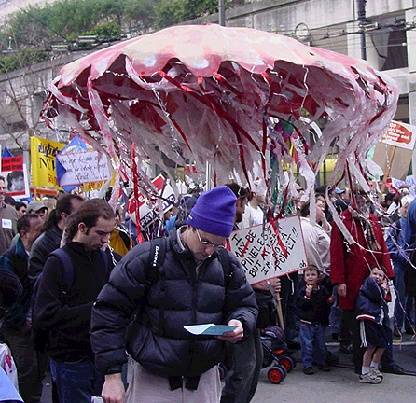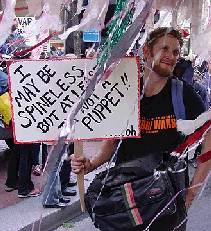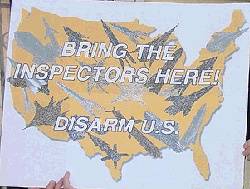“Stop the Madness of King George”: Dispatch from San Francisco
"I may be spineless but I am not a puppet" -- January 18th 2003 antiwar prop.
Closeup of the "May be spineless" sign -- January 18th 2003.
Photos: Glenn Bachmann
Saturday January 18th dawned clear and cloudless in San Francisco. The news coming to us from the East coast over the Pacifica airwaves, the independent radio network founded half a century ago on the eve of the Korean War, was of a bitterly cold day in Washington, DC. Despite the weather, half a million people, according to a later estimate of the Washington Post, were filling the streets of the capital with one message in a thousand versions “No war on Iraq”.
The speeches from the podium at Washington's Lincoln Memorial may have gestured to the memory of Martin King and the huge 1963 civil rights demonstration there, but they lacked the rhetoric of King or the measured irony of his mentor Bayard Rustin, the canny godfather of non-violent direct action who organized that March on Washington, and who had conveyed the anti-nuclear (“peace”) symbol back across the Atlantic from CND's 1959 Aldermaston march. The voices today by contrast came across as desperate, on the edge of hysteria understandable perhaps with the state apparatus in the hands of men such as Cheney, Rumsfeld, Scalia, Ridge and Bush.
By 9.30 a.m. there were long queues outside Bay Area metro stations. The destination was the San Francisco waterfront the Ferry Building plaza at the foot of Market Street, site of the last great American general strike in 1934. The Transit Authority claimed to be laying on dozens of extra trains, though not free like the “social trains” familiar on days of protest in Italy, except when the notorious, time-wasting, “automatic” ticket machines break down. The atmosphere underground, despite the intense crush of people, was festive. The forest of home-grown signs spoke to the themes of the day “No Blood for SUVs”, “Impeach Bush”, “Wage Peace”, “Its the War Economy, Stupid”. To emerge onto the Embarcadero in San Francisco was an astonishing experience, even for veterans of Gulf War protests and Critical Mass bike rides. It was immediately clear that the rowd was massive, one cutting across class and generation, race and religion. This was no somber, monocultural, white-bread “peace” encampment.
It was obviously unprecedented in size, and that was encouraging. For many it was in fact the whole point; the numbers were the “message”. Everyone knew that we were in a numbers game. The figures initially given in the New York Times for the October 2002 demonstration in New York were so flagrantly underestimated (“less than ten thousand” to describe a crowd of around two hundred thousand) that the corporate media, including the private television networks and public radio, changed tack, maybe out of mild embarrassment over the travesty of reportage about the October actions. More likely they were responding to signs from their psephologists and other entrail inspectors of the body civic that there is very widespread anxiety and cynicism about Bush's war plans for Iraq. That is to say, among their target audience.
It also reveals something about the state of the political class in America only one member of Congress, Barbara Lee, has stood with this very large reservoir of resistance. Correlatively, and as a watershed in American politics, none of the posters and placards bothered to address the political apparatus national, state, or local except in scatological or abusive terms: “Lick Bush”, “Senator Feinstein War Profiteer”, “Dump Davis”. And most to the point, a sign invoking an earlier critic of terror : “It is not with much credulity I listen to any, when they speak evil of those whom they are going to plunder--Edmund Burke”.
Notwithstanding, this time around, the planned demonstrations were covered by the local and national media in the days leading up to the events, and even sympathetically. Still, the cunning formula used by the New York Times to describe the Washington crowd of perhaps half a million “tens of thousands” was technically true, while managing by implication to diminish the numbers by at least an order of magnitude. The estimates are the issue here, since the “true” numbers are ultimately undecidable, especially if helicopter overflights are limited for reasons of “counter-terrorism” to agencies of the state.
Soon after midday the head of the march here set off west along Market Street, and people were still leaving the Embarcadero three hours later. One reason to move up Market Street as quickly as possible was to avoid the opening speeches, a grisly amalgam of banality and irrelevance. The crowd was anyway boisterous and frankly indifferent to the harangues of the organizers, an outfit called ANSWER (Act Now to Stop War and End Racism), among whose cadres are fronts for the Workers World Party, originally formed to support the 1956 Soviet invasion of Hungary and currently on record as being in solidarity with Milosevic. Not one in a thousand of those who turned up last Saturday to demonstrate in Washington or San Francisco seemed to know, or care, who the organizers were, and no doubt even fewer did so among those who gathered in cities and towns all across the country for example, 20,000 in Portland and 5,000 in Albuquerque. However, to say that it doesn't matter who does the organizing for domestic resistance to the impending war, just as long as people show up in big numbers on the streets, is a dangerous proposition.
Indeed one nasty consequence has been the airing of mild-voiced Stalinists from ANSWER, who as licensed organizers have become the media voice of the opposition. One of them showed up a few days later on the chattering class's favorite talk-show, National Public Radios Fresh Air. In fact, the authorities like ANSWER's style of demonstration; D.C. Police Chief Ramsey said "They're always very peaceful; you can work with them… They just want to come in and protest. They don't want to cause any damage." [Washington Post, October 21, 2002]. Except, for instance, when on a previous demonstration they threatened the street theatre troupe, Art & Revolution, with big clubs for attempting to share the limelight as agreed.
On this occasion Art & Revolution were stationed half way along Market Street, posing as agents of the Department of Homeland Security, bent on Total Information Awareness, and equipped with surveillance cameras, panoptic Poindexter arm badges, and a handy Mobile Detention Center: “We come to you, to save you coming to us”! Drummers and marching bands echoed around that boulevard of shame, home to not a few of the Californian kleptocracy dissected by Gray Brechin in his book Imperial San Francisco. Nobody paid any attention to the closed offices of Chevron and Bechtel (the Pentagon's civil arm), both firms with global reach poised to reap immense profits from the looming war, or to the corporate law and accounting firms who service their bottom line; at least, not until four o'clock, well after the main body of the march had passed, when a breakaway black and pink bloc, several hundred strong, finessed the riot police and paid a discomfiting visit to some corporate headquarters, a Seattle-based coffee shop, and the Immigration and Naturalization Service offices.
There were very few straight American flags on display compared to last October, when the Stars and Stripes were still being used for protective coloration by those who felt open to the charge of being insufficiently patriotic. The pall of 9/11 seems finally to have lifted. A San Francisco writer, once a barrister to the prison movement, sported a flag T-shirt with missiles in lieu of stripes, and a legend that spoke for the multitude: “United My Ass”.
The crowd was noisy and full of banter, the mood was carnivalesque. The pungent aroma of Northern California's major cash crop drifted through the streets. One long-time chronicler of popular struggles in the city noticed above all “the civic feeling of the event everyone in SF seemed to be there or wish they'd been there.” He remarked too on the range of opinion expressed in the signs and banners, mostly homemade; there was no party line in the crowd, very little rote chanting. Perhaps the strangest sound heard all afternoon came from an antinomian section of the shuffling throng, when it spontaneously took up the chant, “Mil-ton! Mil-ton! Mil-ton!”, having seen a placard hoisted by a labor historian from Mendocino, and inscribed with an ominous gobbet from Paradise Lost:
“See with what heat the dogs of hell advance,
To waste and havoc yonder world…
Till, crammed and gorged, nigh burst
With sucked and glutted offal.”
Another nearby placard bore the 1915 lines from Emma Goldman which University of California censors earlier in the week had tried to excise from a fundraising letter sent out by Candace Falk, keeper of the Emma Goldman Papers: “In the face of this approaching disaster, it behooves men and women not yet overcome by war madness to raise their voice of protest, to call the attention of the people to the crime and outrage about to be perpetrated on them”. On the back was a second censored passage: “We shall soon be obliged to meet in cellars, or in darkened rooms with closed doors, and speak in whispers lest our next door neighbors should hear that freeborn citizens dare not speak in the open”.
Pithier banners read: “Go Solar Not Ballistic”, “Rich Man's War, Poor Man's Blood”, “Stop the Madness of King George”, “Geniuses against War”, “Saddam, Give us Back our Anthrax”, “War is the Health of the State”, “Prevent Mad Cowboy Disease”, “Hand Bookbinders against the Megamachine”, “Bush, Don't Misunderestimate the Peace Movement”, “War is Terrorism”, “Another Gay Mother against U.S. Weapons of Mass Destruction”, “It's the Coke, George It Makes you Mean”, “General Strike Now”.
"Bring the Inspectors Here" -- January 18th 2003 antiwar graphic.
Photo: Glenn Bachmann
One lonely sign, “Peace is Patriotic--That's the Problem”, served as a necessary antidote to the thousands of placards just calling for peace tout court, as if the “peace” process in Palestine, in Ireland, in Algeria has not historically been war by other means. “Peace” in Iraq for the last decade has meant countless deaths by starvation and bombing. Will this pax Americana, namely, neo-liberalism's continuing dispossession of the commoners of the planet, be an improvement on the pax Britannica or, for that matter, the pax Romana? There may be peace, but it will be the peace of cemeteries.
The demonstration was so dense that it took over two hours to walk just the mile and a half along Market Street one hundred and twenty feet wide and the citys major thoroughfare. After about a mile, the corporate behemoths are left behind, the flanking buildings drop in height, and the sun reaches the street. The procession entered a zone of porn theaters, discount stores, and cheap restaurants, and behind them are the skid rows of the Tenderloin, preserved by zoning ordinances to provide cheap housing for the casual labor force needed to staff the city's downtown tourist hotels.
Once they reached the “rally” nearby City Hall, most of the crowd showed a distinct lack of interest either in the celebrities Martin Sheen, Joan Baez, Bonnie Raitt or the peace-mongering speeches. Not that there's no hunger for analysis, though it is true that compared to the demonstrations of the last Gulf War there is almost nothing circulating by way of literature or pamphlets. Its just that we all knew that what was on offer from the podium was rubbish.
We also know that if seven hundred thousand gathered last Saturday in Washington and San Francisco to protest this bloody business, then there must be millions in the United States who reject the fraudulent doctrine of military humanism “mercy by any means necessary” and the pre-emptive state terror (including the use of nuclear weapons) embodied in Bush's new National Security Strategy.
Finally, we know that there is very little time, if this war is to be stopped, and that it will take more than demonstrations. We appreciated George Monbiot's call in the Guardian to raise the temperature by staging “a political drama commensurate with the scale of the threat”, and we especially welcomed the recent action of the Scottish train-drivers who refused to take part in the movement of war materiel at NATO's largest arsenal on the west coast of Scotland. Those who worked the San Francisco longshore in the past well understood the power, at once symbolic and real, of such local acts of refusal to begin the redress of grievances at home and half a world away. On Saturday there were two hundred thousand reasons to hope it shall be so again.
—Iain A. Boal, Berkeley, 27 i 2003



